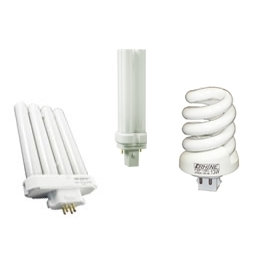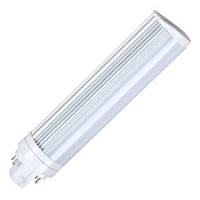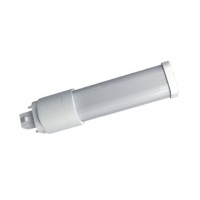
This post has been updated from its original 2013 version.
PL fluorescent lamps have been in the conservation game for a while. Specifically named for the original creator/manufacturer, this lighting solution is both easy on energy consumption while being a bit complicated to understand. To take the guess work of it, here are a few facts about PL lamps.
A Philips Brainchild
Philips Lighting took fluorescent lamps into their own hands with the development of PL lighting, twin-tube fluorescent lamps typically found in non-residential settings (office buildings, retail stores, schools, etc.). Other versions of the lamp come in triple and quad tubes and some can be used for more than just lighting, such as germicidal lamps – lamps used for disinfection.
All About the Base
PL bulbs are pin-based, with either two or four pins, and installing them requires a pin-based lighting fixture. There are many base types, like GX23, with the different names representing the pin configuration of the lamp. In order to find the right lamp for installation/replacement, check the base for details of the type, pin configuration, wattage and light color.
Lamp Brightness
The brightness level of PL lamps is determined by lumens, which measures how bright a bulb is. This is different than wattage, which measures the energy output of a lamp. PL bulbs have the upper hand on incandescents because they use up less energy to display the same or a higher level of brightness. For example, a GX23 PL bulb displaying 840 lumens uses only 13 watts of energy while the incandescent version uses 60.
Color Temp: Warm to Daylight
PL bulbs shine in varying light colors. From warm white to daylight, the specific temperatures are:
- 2700k – warm white
- 2500k – soft white
- 4100k – cool white
- 5000k+ – daylight
Maximum Overall Length
Sometimes a little more information is required to properly install/replace PL lamps. Some fixtures have size limitations known as the maximum overall length (MOL). To find the length of PL bulb, measure from the base to point of the bulb.
Though PL lighting has been around for a while, this cost-effective, energy efficient lamp continues to grow. With a life span between 10-13x their incandescent peers, PL bulbs don’t need to be replaced as often, and (thankfully) you won’t want to.




I found it interesting when you talked about checking a lamp’s energy-efficient features. Recently, my wife and I decided to renovate our garage and outdoor space. We want to get the right lighting for those areas, so we think your article could help us. Thanks for the information on how to understand PL lamps better.